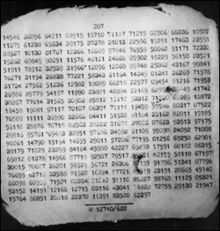Ciphertext
In cryptography, ciphertext or cyphertext is the result of encryption performed on plaintext using an algorithm, called a cipher.
[1] Ciphertext is also known as encrypted or encoded information because it contains a form of the original plaintext that is unreadable by a human or computer without the proper cipher to decrypt it.
Decryption, the inverse of encryption, is the process of turning ciphertext into readable plaintext.
Once the message is encrypted, Alice can safely transmit it to Bob (assuming no one else knows the key).
and decryption proceeds as The history of cryptography began thousands of years ago.
They include: Historical ciphers are not generally used as a standalone encryption technique because they are quite easy to crack.
Many of the classical ciphers, with the exception of the one-time pad, can be cracked using brute force.
An attacker should not be able to find the key used in a modern cipher, even if they know any specifics about the plaintext and its corresponding ciphertext.
Cryptanalysis (also referred to as codebreaking or cracking the code) is the study of applying various methodologies to obtain the meaning of encrypted information, without having access to the cipher required to correctly decrypt the information.
This typically involves gaining an understanding of the system design and determining the cipher.



